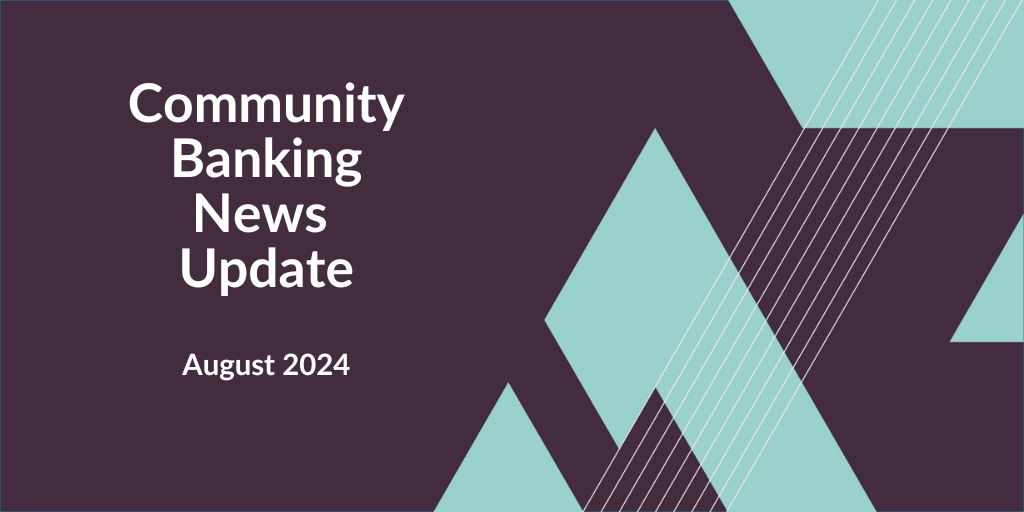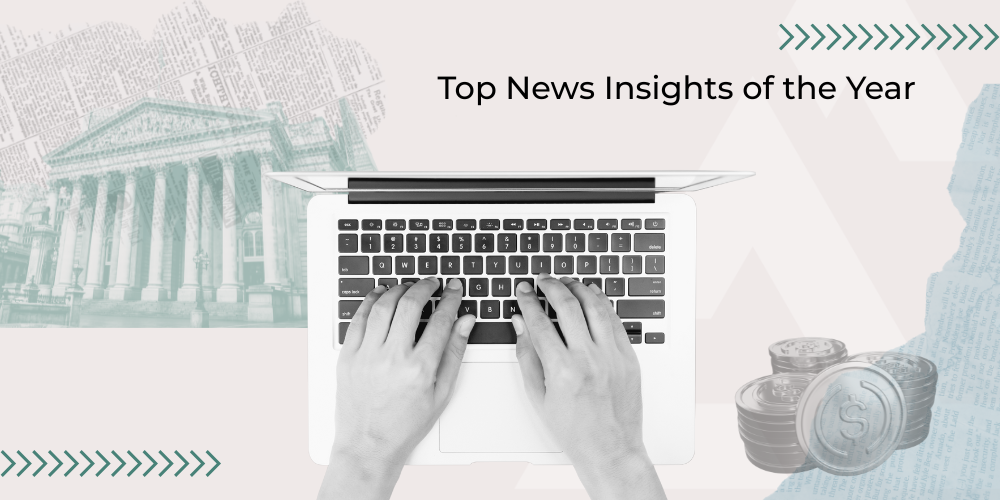Community Banking News Update: Bank Charter Race, Regulatory Relief, M&A Rebound - January 2026
The new year kicks off with new players, new charter access debates, and shifting banking rules. As 2026 gets underway, one theme keeps showing up in...
6 min read
 Daisy Lin, Head of Marketing, Acceleron
:
8/1/24 7:47 AM
Daisy Lin, Head of Marketing, Acceleron
:
8/1/24 7:47 AM

This month's major banking stories and their impact on community banks
Welcome to Acceleron’s new content series, Community Banking News Update. Every first week of the month, we will curate a roundup of significant news stories most relevant to community banks.
Stay informed and sign up for our monthly newsletter to receive the latest community banking news updates directly in your inbox.
New congressional legislation is bolstering efforts by the Federal Reserve to revamp its discount window, an essential emergency lending tool. Senator Mark Warner of Virginia has introduced a bill to modernize the discount window, which offers quick, collateralized loans to banks. The proposed legislation aligns with the Fed's ongoing initiatives to make the discount window more accessible and less stigmatized for banks needing liquidity in times of stress or unexpected financial shortfalls.
Warner said in a statement that the failures of Silicon Valley Bank and Signature Bank last year highlighted the urgent need to reform the Federal Reserve's discount window for the 21st-century economy, “where bank runs can occur over hours, rather than days."
The bill would require all but the smallest banks to regularly test their access to the discount window and mandate that regulators consider a bank's ability to use the facility when assessing liquidity. The bill also calls for the Fed to report to Congress on the stigma issue and suggest further measures to alleviate banks' concerns.
For community banks, these reforms could markedly improve their ability to handle liquidity crises. By alleviating the stigma associated with using the discount window, community banks can more confidently secure emergency funds without the fear of appearing financially unstable. Regular testing of discount window access and increased transparency in liquidity evaluations would enhance the overall financial robustness and readiness of community banks. This ensures they are better prepared to address sudden liquidity needs.
Recent signs of easing inflation may be setting the stage for the Federal Reserve to lower interest rates as early as this fall. Federal Reserve Chair Jerome Powell said that the Fed could cut rates at its next meeting in September if the economic data is favorable and price increases move towards the Fed's 2% target.
The Federal Reserve has raised its benchmark interest rate by 5.25 percentage points since March 2022. Fed officials have indicated that they expect to reduce the benchmark rate once before the end of the year. For the period through 2025, the committee now anticipates five total interest rate cuts equaling 1.25 percentage points.
A potential rate cut by the Federal Reserve holds significant implications for community banks. In the longer term, it could ease pressure on deposits. A rate reduction would lower the interest burden, making it easier for community banks to retain and attract deposits without offering excessively high rates.
Lower borrowing costs resulting from a rate cut can also stimulate loan demand. Community banks serving small businesses and local customers may see an uptick in loan applications as lower interest rates make borrowing more attractive. This boost in loan demand can drive earnings growth for community banks. Furthermore, lower rates could enhance the affordability of mortgages and other personal loans, supporting local economic activity and strengthening the relationship between community banks and their customers. Stay tuned.
Several U.S. mid-sized and regional banks reported a decrease in their second-quarter profit in mid-July, primarily due to higher deposit costs and sluggish loan demand. The squeeze on net interest income (NII) has been a significant factor as high interest rates have dampened loan activity, while banks' efforts to retain customers have increased deposit costs. "High interest rates, an uncertain economic outlook, and alternative financing challenges continue softening demand for traditional bank lending," Chris Stanley, banking industry practice lead at Moody's, told Reuters. He emphasized the need for banks of all sizes to critically examine their growth assumptions in these conditions.
The net interest margin, a critical measure of banking profitability, contracted across the industry for the third consecutive quarter. Huntington Bancshares, Fifth Third Bancorp, Regions Financial, and Comerica all reported lower second-quarter profits, with shares falling by 1.5%, 3%, and 11%, respectively. Banking executives have indicated they are actively working to reduce expenses to counteract the headwinds in interest income. Additionally, the turmoil in commercial real estate (CRE) sectors, highlighted by recent stresses at New York Community Bancorp and First Foundation, has led banks to bolster their allowances for credit losses to prepare for potential loan defaults.
On the upside, other regional banks, such as Zions Bancorp, First Bancorp, and Northwest Bank have managed to beat earnings expectations.
Community banks are likely to face some similar challenges as their larger counterparts, with high deposit costs and reduced loan demand impacting profitability. The contraction in net interest margins will necessitate a closer examination of growth strategies and expense management. While community banks do extensive lending in the commercial real estate sector, most of their loans are for smaller buildings occupied by local businesses. These properties generally do not suffer from the vacancy issues that large office buildings are currently facing. That said, building allowances for credit losses and focusing on stable lending segments, such as commercial and industrial loans, may be prudent steps to mitigate risks.
Additionally, developing sources of non-interest income is crucial for maintaining financial health and sustainability. By diversifying their income streams through fee-based services, community banks can reduce their exposure to interest volatility.
Read our blog about how community banks can increase non-interest income through international payment processing technology.
The Federal Reserve's FedNow instant payments service has outpaced The Clearing House's RTP network in bank participation during its inaugural year. FedNow moves payments in seconds instead of days and has quickly gained traction among financial institutions. FedNow has enrolled approximately 800 participating banks and credit unions, while RTP has attracted about 652 financial institutions. Despite this progress, some major banks, such as Bank of America, Citi, and Capital One have yet to join FedNow.
FedNow's swift uptake indicates a significant shift towards instant payments, reflecting the evolving needs of consumers and businesses for faster and more efficient financial transactions. As the adoption of FedNow continues to grow, it is poised to become a key payment rail in the U.S. payments landscape.
The rapid adoption of FedNow may present opportunities for community banks. As more financial institutions integrate with FedNow, community banks can leverage this platform to offer enhanced real-time payment services to their customers. This capability is increasingly important in a digital economy where consumers and businesses expect instantaneous transactions.
However, community banks must weigh the risks and ensure they have the necessary infrastructure to handle the potential security challenges associated with real-time payments.
The head of JPMorgan Chase's consumer and community banking division, Marianne Lake, has issued a warning that customers may soon have to pay for their checking accounts.
This potential change is attributed to new regulations proposed by the Consumer Financial Protection Bureau (CFPB), which include an $8 cap on credit card late payment fees and a $3 cap on bank account overdrafts. Although the CFPB passed these caps in March, they are currently being appealed by a coalition of bank industry groups. Those banks maintain that the new rules, combined with higher capital reserve requirements, will significantly impact their bottom lines.
If the rule becomes law, Lake says JPMorgan Chase plans to pass these costs onto customers, and she expects other banks to follow suit if the proposed regulations become law.
The introduction of fees on checking accounts by JPMorgan Chase and other big banks may present both challenges and opportunities for community banks. Dissatisfied customers may seek alternative banking options, providing community banks an opportunity to attract new clients by offering fee-free or lower-cost accounts, thus enhancing customer acquisition and retention. These new customers would likely need foreign exchange services that they have come to expect from bigger banks. Community banks that can offer FX services will have an advantage over their competitors.
However, community banks must also carefully evaluate their own fee structures and service offerings to ensure they are on solid financial footing. “Big banks can make up for a dent in consumer banking revenues with profit from their wealth management and investment banking arms,” Dan Goerlich, a consulting partner at PricewaterhouseCoopers, told the Wall Street Journal. “Smaller and regional banks will struggle to make up for that.”
The Federal Reserve's 2024 stress test results have revealed that major U.S. banks can withstand a severe economic downturn scenario. The tests, which assess banks' ability to endure significant financial distress, showed that all 31 institutions tested in the annual regulatory exercise would remain above minimum capital requirements even in the event of a hypothetical severe recession. This scenario included a 40% drop in commercial real estate prices, a 36% decline in housing prices, and a spike in unemployment to 10%. Michael Barr, the Fed’s Vice Chair for Supervision, said the extra capital that banks have built in recent years has been useful in providing a cushion.
Despite the positive outcomes, the tests indicated areas requiring attention. While no bank faced significant difficulties in this year’s exercise, the group’s aggregate capital levels fell by 2.8 percentage points, a larger decline than last year. This decrease is attributed to the industry holding more downgraded corporate bonds and consumer credit card loans. Additionally, lending margins and fee income have tightened compared to the previous year, according to the Fed.
The Federal Reserve's stress test results have significant implications for community banks. While these tests primarily focus on major U.S. banks, the findings highlight broader trends and risks that can impact the entire banking sector. Community banks can glean valuable insights into the importance of maintaining strong capital levels and diversifying their asset portfolios to mitigate risks. Furthermore, the issues identified in the stress tests, such as holding consumer credit card debt, which hit a recent high, are relevant for community banks as they navigate their lending practices and risk management strategies.
Acceleron builds patented software that allows community banks and credit unions to conduct international payment transactions profitably through a foreign exchange (FX) marketplace. Serving over 200 financial institutions and orchestrating more than $1 billion in international payments annually, Acceleron helps small banks generate non-interest income and compete more effectively with high-fee big banks. Our solutions integrate seamlessly with top payments plaforms ensuring quick implementation and smooth operation.
Contact us to book a meeting.

The new year kicks off with new players, new charter access debates, and shifting banking rules. As 2026 gets underway, one theme keeps showing up in...

The insights community banks turned to most in a year of rapid change, from tokenized desposits to international payment automation. Rapid change...

International wire automation, stablecoins, wallets, and AI reshape global money movement What a pivotal year in cross-border payments. No one...